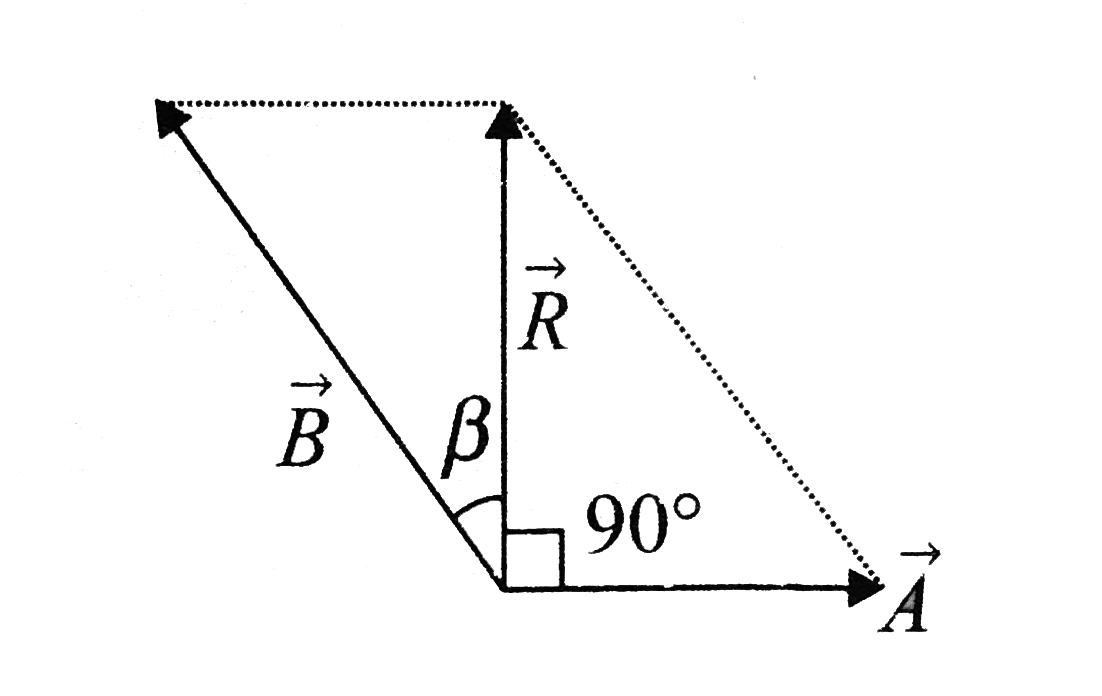The resultant of two vectors →Aand→B is perpendicular to the vector →A and its magnitude is equal to half the magnitude of vector →B. What is the angle between →Aand→B ?
Let angle between →Aand→B be θ
Let →C=→A+→B
Let α be the angle between →Cand→A, then we can write the following :
tanα=BsinθA+Bcosθ
Here α=90∘
⇒tan90∘=BsinθA+Bcosθ
A+Bcosθ=0
Magnitude of vector →C can be written as follows:
⇒C=√A2+B2+2ABcosθ
Here C=B/2
⇒B24=A2+B2+2ABcosθ
We can substitute from equation (i) : Bcosθ=−A
⇒B24=A2+B2−2A2
⇒A2=34B2⇒AB=√32
Substituting the above result in equation (i) again , we get the following :
cosθ=−√32⇒θ=150∘
Hence the angle between the two given vectors is 150∘
Topper's Solved these Questions
- BOOK - MODERN PUBLICATIONCHAPTER - MOTION IN A PLANE EXERCISE - Revision Exercises (very Short Answer Questions)46videos
MOTION IN A PLANE
- BOOK - MODERN PUBLICATIONCHAPTER - MOTION IN A PLANE EXERCISE - Revision Exercises (Additional Questions)4videos
MOTION IN A PLANE
- BOOK - MODERN PUBLICATIONCHAPTER - MOTION IN A PLANE EXERCISE - NCERT FILE (Solved) (NCERT (Exemplar Problems Subjective Questions) Very short nswer type questions)13videos
MOTION IN A PLANE
- BOOK - MODERN PUBLICATIONCHAPTER - MECHANICAL PROPERTIES OF FLUIDSEXERCISE - Chapter Practise Test16videos
MECHANICAL PROPERTIES OF FLUIDS
- BOOK - MODERN PUBLICATIONCHAPTER - MOTION IN A STRAIGHT LINE EXERCISE - CHAPTER PRACTICE TEST16videos
MOTION IN A STRAIGHT LINE
Similar Questions
The resultant of two vectors →Aand→B perpendicular to the vector →Aanditsmagnitudequal→halfofthemagnitudeofthe→−−→r vec B.F∈doutthe∠between vec A and vec B.
View SolutionThe resultant of two velocity vectors →A and →B is perpendicular to →A. Magnitude of Resultant →R is equal to half magnitude of →B. If the angle between →A and →B is (30θ)∘, then value of θ is ?
View Solution
Knowledge Check
- Question 1 - Select One
The resultant of two vectors →A and →B is perpendicular to the vector →A and its magnitudes is equal to half of the magnitudes of vector →B (figure). The angle between →A and →B is
 A120∘B150∘C135∘DNone of these
A120∘B150∘C135∘DNone of these - Question 2 - Select One
Two vectors →A and →B have equal magnitudes. If magnitude of →A−→B is equal to (n) times the magnitude of →A−→B, then angle between →A and →B is ?
Acos−1(n−1n−1)Bcos−1(n2−1n2+1)Ccos−1(n−1n−1)Dcos−1(n2−1n2+1) - Question 3 - Select One
Two vector →Vand→V have equal magnitudes. If magnitude of →A+→B is equal to n time the magnitude of →A−→B, then angel to between →Aand→B is
Acos−1(n−1n+1)Bcos−1(n2−1n2+1)Csin−1(n−1n+1)Dsin−1(n2−1n2+1)
Three vectors →A,→B and →C are related as →A+→B=→C .If vector →C is perpendicular to vector →A and the magnitude of →C is equal to the magnitude of →A, what will be the angle between vectors →A and →B.
View SolutionTwo vectors →Aand→B have equal magnitudes.If magnitude of (→A+→B) is equal to n times of the magnitude of (→A−→B) then the angle between →Aand→B is :-
View SolutionTwo vectors vec A and vec B have equal magnitudes.The magnitude of (vec A+vec B) is 'n' times the magnitude of (vec A-vec B).The angle between vec A and vec B is:
View SolutionIf a,b,c are three mutually perpendicular vector each of magnitude unity, then what is the magnitude of ∣∣→a+→b+→c∣∣?
View SolutionTwo vectors →a and →b are such that ∣∣→a+→b∣∣=∣∣→a−→b∣∣. What is the angle between →a and →b?
View Solution

